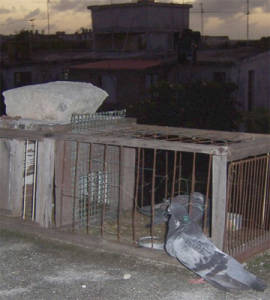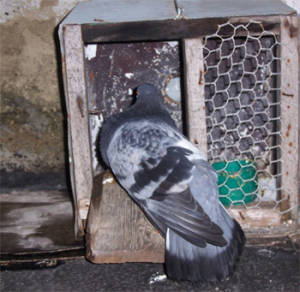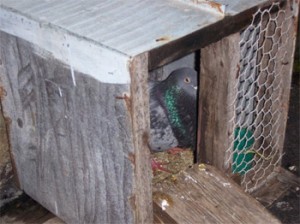Cuba’s Pigeon Breeders
Regina Cano
 HAVANA TIMES, Jan 2 — One can go through the neighborhoods of Havana and see kids (teenagers) looking up toward the sky, observing, or better said, looking for something. For those who are unfamiliar, this seems like something lacking an explanation.
HAVANA TIMES, Jan 2 — One can go through the neighborhoods of Havana and see kids (teenagers) looking up toward the sky, observing, or better said, looking for something. For those who are unfamiliar, this seems like something lacking an explanation.
However, the situation is one of pigeon breeders, who have always existed in every district of Havana ever since I was little, and I think that now there are even more.
“Did you see how that one took off of the roof.”
“Yeah, that’s a good one, look how it does the jala (attracts another pigeons)”.
“I have one of the best, it has “legs”(meaning that it doesn’t land on other roofs) as well as “seduction” (it attracts other birds with its flying and cooing).”
Accused of ruining roofs, snapping off TV antennas from their birds’ weight, and not letting people sleep (from their walking around on rooftops), the “Palomeros” (pigeon breeders) form a guild of “collectors”; they are also those who supply the market.
Pigeons here can cost between 25 and 50 pesos (1 to 2 USD). The general price is decided by the breeder but is determined exactly through negotiation. The buyers are themselves experienced breeders, novices or people who use the birds for sacrifices in brujeria (Afro-Cuban sorcery), for which some people prefer white pigeons.
 The most common breeding birds are the Buchonas (Raspeños, Laudinos and Morilleros), the Messengers (with red marks on their beaks and feet) and the Marroqui (or Moroccans). The predominant colors are white, blue, gray, piebald, smoked, white, brown and black.
The most common breeding birds are the Buchonas (Raspeños, Laudinos and Morilleros), the Messengers (with red marks on their beaks and feet) and the Marroqui (or Moroccans). The predominant colors are white, blue, gray, piebald, smoked, white, brown and black.
People also engage in the robbing of pigeons from other roofs by using other pigeons. This is done with birds that are good for this (males or females), and which are managed by the hands of their palomero.
Some breeders put rings on the legs of their birds, where they write their own names and the date of the bird’s birth. If someone comes to claim their pigeon, this can be a problem, because with or without the rings the owners know their birds.
The brood is usually feed once or twice a day with beans, peas or corn, which provide them vitamins.
The males and females are generally kept separate, putting them together when they’re mates. They share in the “brooding” (7 to 10 days) and the feeding the nestlings, though they alternate the task: “one feds the young and the other rests.” The chicks hatch in 19-21 days, with a survival rate of 50 percent, and can reach the age of seven or eight years.
 It sometimes seems we’re infested with pigeons, but diseases actually serve to regulate this population. Smallpox, “culillo,” “trazas,” intestinal parasites and hernias in the female, maintain this population at bay, despite the work of veterinarians. These represent risks to humans as well.
It sometimes seems we’re infested with pigeons, but diseases actually serve to regulate this population. Smallpox, “culillo,” “trazas,” intestinal parasites and hernias in the female, maintain this population at bay, despite the work of veterinarians. These represent risks to humans as well.
The “Pigeon Society” (Spanish: Sociedad Colombofila) exists in Cuba, but the vast majority of breeders have no relationship to it.
Their breeders claim that they seek entertainment and competition (indeed they say that there’s an event in Guanabacoa).
What’s certain is that this custom is maintained in a way similar to that of playing baseball in the street, and more than a few quarrels and vendettas have emerged out of this practice.
One can just as easily see a child as a 50-year-old man breeding these birds. Some do it as a business and others for pure hobby. The business often takes shape after the hobby, but in the end the breeder ends up losing sleep over their brood.






Some fellow cruisers found a FCC banded pigeon on the deck of the Carnival Breeze just hanging out.
Friday April 20 while we were returning from the Bahamas to Galveston Texas . I couldn’t read all the information from the pics but it said FCC Cuba and the number ended in 95. The only part of the year I could read was the 20. I have pics if anyone wants them. I am not sure where he went from the boat.
Lost Cuban pigeon.
We have in Belize, Cuban Pigeon No 192228. It got blown away from Cuba in a race. Exhausted it landed on a yacht travelling past Cuba to Belize. What shall we do to get it back to you? Also what is the best food to feed it? It likes Reggae now. It seems very happy but does not speak English.
Hope we can help you.
George
PIGEON CLUBS IN CUBA,I HAVE FOUND LAST NIGHT A DARK PIGEON IN GOOD HEALTH IN MY LOFT WITH A RING AND A RACING BAND ON THE OTHER FOOT I WILL LIKE SOME ONE TO CONTACT ME IN ENGLISH SO I CAN SHARE THIS WITH THEM.
Hello. I rescued a pigeon with 2 bands yesterday. One band reads FCC 2010 038520 and the other band is green but no markings on it. What should I do? I live in Mobile, Alabama. It appears to be in good health.
Hi everyone ! I am looking for wholesaler / big shop with pigeon supplies on Cuba, does anyone know any? i would be very thankful for any names or links to those shops.
We have found fcc 036973 in the Cayman Islands.
I have posted pictures here: http://www.pigeons.biz/forums/f20/need-help-with-cuban-racer-found-in-louisiana-62889.html
thank you so much for your help –
We will try to make the contact for you.
I live 900 miles away in the US, and found a pigeon from Cuba recently. I found your lovely article here while trying to find out how to contact the bird’s owner. Do you have any idea how to reach the Federación Colombófila de Cuba? I need to let someone there know:
Me encontré con una paloma perdida con este número: FCC 2010 025397
Somebody there loved this bird, and would like to know that it survived the storm. Thank you . . . .
hola soy un amigo italiano que volve a havana el 21 febrero 2012, ma gustaria mucho encontrarte porque me presntas los criadores de paloma e de tortolas. adios.